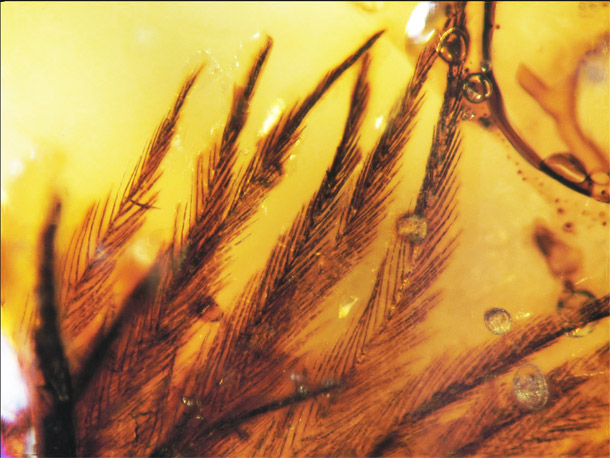Science News
Amber Dinosaur Feathers

A University of Alberta research team has turned up a treasure trove of Cretaceous feathers trapped in tree resin. The resin turned to sturdy amber, preserving some 80 million-year-old proto-feathers, possibly from non-avian dinosaurs, as well as plumage very similar to modern birds, including those that can swim under water.
Paleontology graduate student Ryan McKellar discovered a wide range of feathers among the vast amber collections (more than 4,000 pieces!) at the Royal Tyrrell Museum and other Canadian museums. Much of these stem from Canada’s most famous amber deposit, near Grassy Lake in southwestern Alberta.
Out of the 4,000 pieces examined, McKellar turned up 11 that contained feather specimens.
While no dinosaur or avian fossils were found in direct association with the amber feather specimens, the feathers look to belong to both groups—avian and non-avian. The New York Times describes the feather structures that led to this conclusion.
One specimen of so-called proto-feathers [belonging to the non-avian dinosaurs] had a single bristlelike filament and some simple clusters. Others were complex structures with hooklike barbules that act like Velcro; in modern birds, this keeps feathers in place during dives. Still other specimens revealed feather patterns for flight and underwater diving.
The non-avian dinosaur evidence could point to small theropods as the source of the feathers. Some of the feather specimens with modern features resemble those of modern birds like the Grebe, which can swim underwater. The feathers can take on water giving the bird the ballast required to dive more effectively.
McKellar says the Grassy Lake find demonstrates that numerous evolutionary stages of feathers were present in the late Cretaceous period and that plumage served a range of functions in both dinosaurs and birds.
Nature News describes this evolution in detail:
Feathers' evolutionary origin remains murky, but palaeontologists propose that they started off as simple, flexible filaments similar to those in the coat of 'dino fuzz' that covered the small predatory dinosaur Sinosauropteryx. From there, feathers adapted to become complex branching structures, eventually culminating in the asymmetrical flight feathers of the early bird Archaeopteryx and its living relatives.
The amber preserves microscopic detail of the feathers and even their pigment. McKellar describes the colors as typically ranging from brown to black. The ancient amber cannot be broken to discover more about the color, but high-resolution X-ray imaging could provide more information about the feathers’ melanosomes in the future.
The research was published today in the journal Science.
Image: Science/AAAS